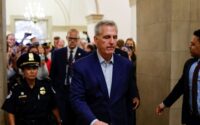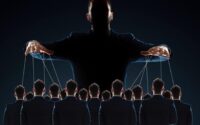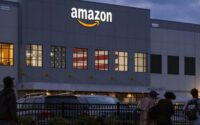Powell starts second term with greatest challenge yet
Federal Reserve Chairman Jerome Powell battled a president who threatened to fire him, a once-in-a-century economic collapse, the uncertainty driven by COVID-19 and the high inflation it spurred during his first term leading the central bank.
His second term isn’t looking any easier.
Fresh off a resounding vote of confidence from the Senate, Powell’s next challenge is perhaps his toughest since taking the helm of the central bank in 2018: leading a successful effort to curb inflation without derailing an otherwise strong economy.
“We fully understand and appreciate how painful inflation is, and that we have the tools and the resolve to get it down to 2 percent,” Powell said in a Friday interview with Marketplace, his first since the Senate voted 80-19 in favor of his confirmation Thursday.
The Fed aims for 2 percent annual inflation as measured by the personal consumption expenditures price index, just a third of March’s 6.6 percent annual increase.
“We’re going to do that,” he continued. But Powell warned the process of getting inflation down to 2 percent “will also include some pain.”
The Fed’s ultimate goal is to raise interest rates at a fast enough clip to slow both consumer and business spending. As households and firms face higher borrowing costs, they are less likely to spend money on goods and services in high demand. The resulting dip in demand should theoretically force prices to stabilize, with fewer buyers willing to buy goods and services at prices driven up over the course of the year.
“If we had the recovery we’ve had, and we had to tolerate a few years of high inflation but then it got back to business as usual, then maybe at some point, historians of the future will say, ‘Well, it was a worthwhile tradeoff,’” said David Beckworth, senior research fellow at George Mason University’s Mercatus Center, a libertarian-leaning think tank.
“Now if on the other hand, we get to a future where inflation has become unanchored and it’s just spiraling out of control, then the Fed’s going to look really bad and we will look back at this point as a turning point,” he continued.
Powell and the Fed jumped into action as the onset of the COVID-19 pandemic shook the U.S. economy in March 2020. The bank slashed its baseline interest rate range to near-zero levels and bought trillions of dollars in bonds to keep money and credit flowing through the economy.
The Fed also deployed billions of dollars in emergency loans, ramping up emergency tools last used to staunch the blow of the Great Recession.
By many measures, the Fed’s response — with the help of nearly $6 trillion in fiscal stimulus — was a resounding success.
The unemployment rate plunged from 14.7 percent in April 2020 to 3.6 percent last month, just 0.1 percentage points above its pre-pandemic level. The U.S. has gained back all but 1.2 million of the 21 million jobs lost during the pandemic, with a record 6.5 million added in 2021 alone.
But the rapid recovery of the economy came with a surge of inflation that now threatens to unwind the economic gains the Fed helped foster.
Annual inflation hit 8.3 percent in April, according to the Labor Department’s consumer price index, a slight decline from March’s annual rate of 8.5 percent. While headline inflation may have peaked already, prices for food, transportation, shelter and health care rose at an even faster pace month-over-month.
Top Fed officials, along with scores of economists, believed inflation would cool last year as pandemic-driven supply chain snarls unwound, fiscal stimulus faded and workers reentered the labor force in greater numbers. Powell said throughout 2021 that the Fed would be patient in pulling back its bond purchases and raising interest rates, lest they cut short a rapid recovery.
“There were a couple of issues, I think, that are related primarily to the pandemic itself and the way that it’s scrambled the usual indicators that made it harder for the Fed to read the economy,” former Fed Chairman Ben Bernanke said in a Monday interview on CNBC.
“The Fed believed in the middle of 2021 that these factors would likely solve themselves over time — that, in other words, that the supply shocks were called transitory and so … they didn’t need to respond to the early stages of inflation because it was going to go away by itself. That proved wrong.”
Powell and the Fed must now raise interest rates rapidly toward, and likely above, a level that would slow the growth of the economy in order to slow the rate of price increases. The Fed chief has made clear the bank will do whatever it takes to stop inflation, which some economists fear could mean raising rates to a level likely to cause a recession.
The Fed can fight inflation by reducing the demand for goods, which means making it too expensive for many households and businesses to maintain their current spending habits. The bank hopes that between a combination of actual rate hikes and hints toward future ones, banks and lenders will raise interest rates enough on their own to slow the economy to a more sustainable pace.
“It’s the market doing the heavy lifting, because it’s convinced that the Fed is going to follow through and do whatever is necessary to bring inflation down,” the Mercatus Center’s Beckworth said. He added that Treasury bond yields, which influence mortgage and auto loan interest rates, have already risen substantially since the Fed began hiking in March.
Even so, Fed rate hikes will do little to help lift COVID-19–related factory and port shutdowns in China or end the war in Ukraine’s severe shock to global food and energy supplies — both of which are set to drive inflation higher. The combination of higher interest rates and steadier price growth could be enough to slow a strong economy in much deeper pain.
“This is not the kind of scenario where we’re seeing rising prices that monetary policy was built to address,” said Michael Mitchell, research and policy director at the Groundwork Collaborative, a progressive research nonprofit.
“By going forward with interest rate hikes right now, they’re actually condemning a lot of people, a lot of workers and families to greater costs and more difficulty in making ends meet.”
[ad_2]
Source link


